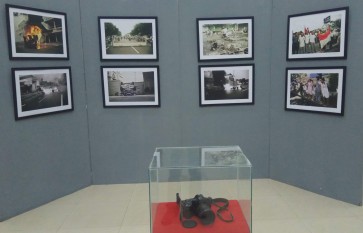Popular Reads
Top Results
Can't find what you're looking for?
View all search resultsPopular Reads
Top Results
Can't find what you're looking for?
View all search resultsCartoons draw youth culture in shallow light
LIFE'S A CARTOON: Young people are so critical, especially about fashion and style
Change text size
Gift Premium Articles
to Anyone

LIFE'S A CARTOON: Young people are so critical, especially about fashion and style. Green is the new black, as shown by Indonesian cartoonist Benny Rachmadi. (JP/Ary Hermawan)
The Asian region did not naturally arrive at "modernity". It was brought to the region not long after adventurous sailors from the West -- then infatuated by inventions and discoveries -- "discovered" the East.
For those who lived in the first decades of the twentieth century, embracing modernity, which was historically conceptually developed in Europe, was a matter of choice, since the great traditions of the East still prevailed when it came along with colonialism.
The older generation was at the time at the crossroads between staying with tradition and shifting to modernity.
The situation is now far different in the twenty first century, when modernity is no longer associated with the steam engine or romantic political activism, but rather with one's ability to keep up on the ongoing rapid development of information technology and its cultural consequence -- the ascendancy of popular culture.
Asian youths today are not simply being torn between modernity and traditions, as they perceive that the cultural disparities between the East and the West had started to diminish. They are now driven to a global culture that considers "coolness", rather than rationality and beauty, as the core of its ethical and aesthetical values.
Ten Asian cartoonists amusingly tell all about it through their drawings, which are being displayed at the 11th Asian Cartoon Exhibition at the Japan Foundation from April 25 to May 19. They are from Bangladesh, China, India, Indonesia, Japan, Malaysia, the Philippines, Sri Lanka, Thailand and Vietnam.
Each depicts youth culture and the problems their generation is facing in their own countries in order to "share and show the similarities and the differences of their experiences," Diana S. Nugroho, the foundation's cultural program officer said.
In China, cartoonist Xia Dachuan explores through his drawings how young people are becoming more and more, though not yet completely, estranged from old traditions.
"Young people are losing sight of their own roots in the wave of globalization and are feeling a void developing between them and traditional culture," he writes in a cartoon depicting the Buddha working in a factory.
In India, however, traditions survive, but not without irony as the new generation demands simplicity and tends to avoid tedious and confounding philosophical lectures.
Indian cartoonist Jayanto Banerjee shows that Indian youths, now more permissive and progressive compared to their elders, are susceptible to being bewildered in a fast-paced world and at times seek age-old wisdom. But instead of attending a spiritual guru, now they can just visit www.secretoflife.com.

Indian writer Vatsala Kaul said 54 percent of India's population were young people under the age of 25. About 16 million of them are the urban young who consume lifestyle brands and define popular youth culture.
"Think of India and images of an ancient culture comes to mind. But things have been changing -- and changing rapidly in the past few decades. The bottom line is: India is young," he writes.
In some places, it appears that young people return to old traditions not because they "have to" for dogmatic reasons as the older generation did in the past, but they use them more for pragmatic, individualistic reasons.
In one of his pieces, Vietnamese cartoonist Lap shows that even in today's high-tech world, young Vietnamese girls, with their pricey gizmos and branded body accessories, still resort to traditional fortune-telling to peek at their destinies.
In Asia today, traditions are not abandoned but they are repackaged and modified in such a way that they could be incorporated in pop culture and even be considered "cool". They are preserved, but unfortunately also perceived as nothing more than another item of the unlimited options of lifestyle and worldviews provided by the Internet.
Alas, as Indonesian cartoonist Benny Rachmadi said, developments in IT -- and technology in general -- have their pitfalls. Both Benny and Japanese cartoonist Suu Kohma depict young people who have been overly exposed to computers and video games in the past decades -- to the point that they are not only alienated from their culture, but from reality as well.
Sitting before their computer screens, the youth in Kohma's cartoons are able to experience in virtual life the suspense of warfare, a chivalrous battle between medieval knights, a boxing match, an aching love story or an imaginary world of goblins and monsters.
"Youth at times want to escape from reality and become so engrossed in computer games that they become part of them," he says, explaining his drawings.
Dachuan believes many youths have become lazy because of technology, which is something that often annoys the older generation.
On his drawing entitled Short cut, Dachuan highlights how technology has increased young people's fondness for short cuts and avoiding hardships-- so much that he believes they would take an elevator to reach the top of a mountain, instead of hiking, if they could.
In the realm of art, Chinese youths are now also avoiding "sophisticated art" and often complain "we can't understand them!" because in their mind, he says, art is only "animation and other entertainment works".
In the digital era, according to Benny, conventional occupations such as doctors, teachers and policemen are no longer as interesting as they were a few decades ago, especially when reality shows offer new kinds of dreams.
While they are interested in working in the IT industry, many in the younger generation are thinking of becoming a star and gaining success in the world of showbiz. This shows that the idea of "coolness" also pervades the way the youth perceive their future.
Most cartoonists aim to humorously portray the predicaments and the oddities of youth culture in Asia as it runs into an unimaginable, digitalized world -- where a young man, as drawn by Philippino cartoonist Lyndon Gregorio, shouts "will somebody answer that stupid phone!?" while listening to a singing bird.
The crucial questions are not whether Asian youths have left their traditions and become estranged from reality, as they probably have, or whether change is good or bad, as is naturally inevitable. There is one question we need to ask ourselves: Are we prepared for the future?










